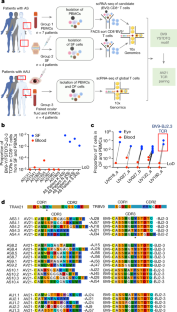自己免疫疾患の診断・治療法開発に道を拓く研究成果 Study opens pathway to better diagnosis, treatment of autoimmune diseases
2022-12-07 ワシントン大学セントルイス
ワシントン大学医学部(セントルイス)、スタンフォード大学医学部、オックスフォード大学の研究者らは、自己免疫を引き起こす重要なタンパク質断片と、それに反応する免疫細胞を見つける方法を開発した。この研究成果は、12月7日発行のNature誌に掲載され、自己免疫疾患の診断と治療につながる有望な道筋を開くものです。
脊椎や骨盤の関節炎を伴う強直性脊椎炎と、目の炎症を特徴とする急性前部ぶどう膜炎という自己免疫疾患は、両方とも、HLA-B*27というHLA変異体と強い関連性を持っています。強直性脊椎炎とHLA-B*27の関連は50年前に発見され、疾患とHLA変異体との関連が初めて確認されたものの一つであり、現在でもあらゆる疾患とHLA変異体との関連で最も強く知られているものの一つとなっています。
HLAタンパク質ファミリーは、免疫細胞が侵入してきた病原体を検出したり、微生物とヒトのタンパク質を区別したりするのに関与しており、個人間で大きく異なっています。HLAタンパク質は、微生物やヒトなど、どのタンパク質の断片が転がっていても、それを拾ってT細胞と呼ばれる免疫細胞に見せ、危険な兆候(微生物)かそうでないか(ヒト)を判断させる手のような働きをするのです。
スタンフォード大学のK. Christopher Garcia博士とXinbo Yang博士、オックスフォード大学のGeraldine M. Gillespie博士とAndrew J. McMichael博士、Lee Garner博士は、横山教授とワシントン大学の Michael Paley博士(共同著者)と共同で、見つけにくい断片を見つけるための新しい方法を考案した。研究チームは、強直性脊椎炎患者の血液や関節、ブドウ膜炎患者の眼球に多く存在する特定のT細胞を特定した。
そして、HLA-B*27と結合したときにT細胞反応を引き起こすタンパク質断片を特定する方法を考案し、その断片をヒトゲノムと5種類の細菌ゲノムにマッピングして、断片の起源となったタンパク質を特定した。この手法により、何百万通りもあった可能性を、ヒトと微生物のタンパク質からごくわずかしか絞り込むことができた。次に、両群の患者から採取したT細胞上のT細胞受容体と呼ばれる検出分子の構造を決定し、それらを比較した。その結果、驚くほどの類似性が確認された。
今回の発見は、強直性脊椎炎、前部ぶどう膜炎、そして、潜在的に他の多くの自己免疫疾患の基礎となる生物学的メカニズムの重要な側面を明らかにしています。
<関連情報>
- https://source.wustl.edu/2022/12/evidence-of-autoimmunitys-origins-uncovered-via-new-approach/
- https://www.nature.com/articles/s41586-022-05501-7
自己免疫関連T細胞受容体はHLA-B*27結合ペプチドを認識する Autoimmunity-associated T cell receptors recognize HLA-B*27-bound peptides
Xinbo Yang,Lee I. Garner,Ivan V. Zvyagin,Michael A. Paley,Ekaterina A. Komech,Kevin M. Jude,Xiang Zhao,Ricardo A. Fernandes,Lynn M. Hassman,Grace L. Paley,Christina S. Savvides,Simon Brackenridge,Max N. Quastel,Dmitriy M. Chudakov,Paul Bowness,Wayne M. Yokoyama,Andrew J. McMichael,Geraldine M. Gillespie & K. Christopher Garcia
Nature Published:07 December 2022
DOI:https://doi.org/10.1038/s41586-022-05501-7

Abstract
Human leucocyte antigen B*27 (HLA-B*27) is strongly associated with inflammatory diseases of the spine and pelvis (for example, ankylosing spondylitis (AS)) and the eye (that is, acute anterior uveitis (AAU))1. How HLA-B*27 facilitates disease remains unknown, but one possible mechanism could involve presentation of pathogenic peptides to CD8+ T cells. Here we isolated orphan T cell receptors (TCRs) expressing a disease-associated public β-chain variable region–complementary-determining region 3β (BV9–CDR3β) motif2,3,4 from blood and synovial fluid T cells from individuals with AS and from the eye in individuals with AAU. These TCRs showed consistent α-chain variable region (AV21) chain pairing and were clonally expanded in the joint and eye. We used HLA-B*27:05 yeast display peptide libraries to identify shared self-peptides and microbial peptides that activated the AS- and AAU-derived TCRs. Structural analysis revealed that TCR cross-reactivity for peptide–MHC was rooted in a shared binding motif present in both self-antigens and microbial antigens that engages the BV9–CDR3β TCRs. These findings support the hypothesis that microbial antigens and self-antigens could play a pathogenic role in HLA-B*27-associated disease.


